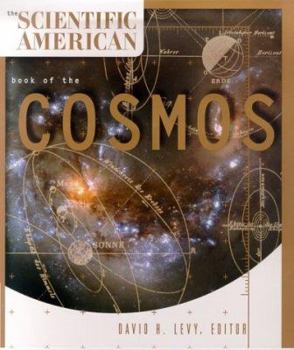The Scientific American Book of the Cosmos
Select Format
Select Condition 
Book Overview
Finally, the entire body of our scientific knowledge of the universe is available in one definitive volume. Scientific American , the oldest and most popular science magazine in the world, has... This description may be from another edition of this product.
Format:Hardcover
Language:English
ISBN:0312254539
ISBN13:9780312254537
Release Date:November 2000
Publisher:St. Martin's Press
Length:416 Pages
Weight:2.38 lbs.
Dimensions:1.3" x 7.8" x 9.6"
Customer Reviews
3 ratings
It can help the general reader better understand the cosmos
Published by Thriftbooks.com User , 19 years ago
This collection of 'Scientific- American' articles aims to provide a comprehensive guide to our understanding of the Cosmos. It has an opening section with three 'historical articles' .The first is one which revolutionized Astronomy in that it instructed amateur astronomers on how to make important scientific observations. The second by Schrodinger has to do with the nature of Matter. And the third, is an Einstein article on Gravitation. The volume attempts to explore the Origin and Possible End of the Universe. Its last chapter has a group of speculations on this subject. It also has an article by Drake and Sagan on exploring for extraterrestial life. Stephen Gould provides an article on the Evolution of Life on Earth. There is a section on the evolution of the Galaxies, and also one on the overall evolution of the Cosmos. Various articles address subjects much written and talked about today from ' superstring theory' to ' the nature of dark matter'. I am not a person with scientific training or great scientific knowledge. I am not capable of really commenting on the ' scientific level' of most of the essays. I read as a general reader who wishes to better understand the world. In this a work like this has much more in it than I am capable of really absorbing and understanding . I believe it will be of value to most people who wish to know and understand the Cosmos in a better way than they do now.
A survey of the stars...
Published by Thriftbooks.com User , 20 years ago
The Scientific American 'Book of the Cosmos' is a collection of articles from the pages of the respected magazine Scientific American; these articles all deal in way or another with astronomy, astrophysics, planetary science and similar studies. Because it is a collection of articles, it has no particular narrative outline running through each section, but rather each section hangs together by general theme.The articles are all fairly recent pieces, save for those that are specifically historical in nature. However, given the nature of periodical writing, many pieces are speculative, and some are already outdated -- but such is the danger in science writing. Things are always changing.The first section draws some key articles from the history of Scientific American, with notable names such as Albert Einstein on gravitation and Erwin Schrodinger on matter. The section begins, however, with Albert G. Ingall's 1925 article that began a revolution in amateur astronomy, urging people to construct their own telescopes. Astronomy remains to this day one of the very few academic disciplines in which amateurs consistently make discoveries of importance to professionals.The collection of essays then proceeds to looking at theories of the birth of the universe and large scale structures, galactic astronomy, and our own galaxy the Milky Way. From this grand cosmic tour the book looks at planetary science, with articles on the birth of solar system and various components in it, the different planets including the earth and moon, and finally looking at life on earth, and the search for life and intelligence on other planets. Finally, the articles look at the smallest parts of the universe -- elementary particles, quantum ideas and the early time in the universe, concluding where we started with large-scale cosmological ideas of the universe, and different theories of the inflationary and self-reproducing universe. As stated before, these articles do not hang together consistently in the way they might if they were written with the intention of being co-chapters in a book. To me, this is not a significant flaw, unless one is looking to this as an 'only' book on astronomy. As someone who has dozens of books on the subject, I find this collection interesting and worthwhile. The list of contributing authors to this volume is impressive; in addition to Einstein, Schrodinger and Ingalls mentioned above, other authors include Carl Sagan, Frank Drake, Wendy Freedman, Stephen Jay Gould, and many other top names in the scientific arena. David Levy, the editor of this volume, typifies the respect amateur astronomers receive in the field. Levy is himself an amateur astronomer; if his name seems familiar, it is because he is one of the co-discoverers of Comet Shoemaker-Levy 9 that plunged into the Jupiter atmosphere with its firey display in 1994. Levy has written a brief introductory piece for each section, outlining the importance of the topic in the large
the best general survey and the best authority together
Published by Thriftbooks.com User , 23 years ago
why on earth, no pun intended, would anybody be disappointed in this terrific book that brings together cosmological thought from Einstein to Sagan, all in one package?This is a rich source for further meditation on the cosmos, nicely designed and illustrated.






